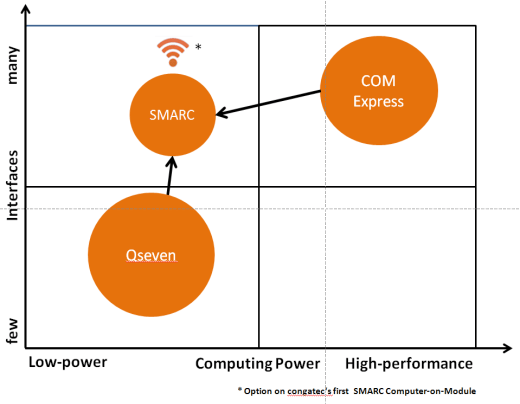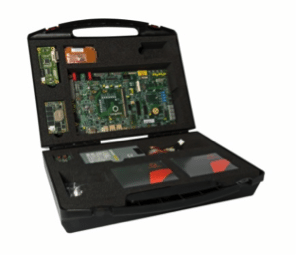Computer on Modules (COM) will play an important role in the IoT and with the recent introduction of the SMARC 2.0 standard, OEMs will have access to the latest display interfaces and highest performance processors in one of the smallest and most innovative form factors available.

Mobility is a key part of modern electronics, which is ably supported by modular design. Most modern consumer devices are not designed to be upgraded, often citing optimizations for their lack of flexible design. But the same performance found in these closed systems is now available in an open and modular format. This modular approach allows OEMs in the consumer, industrial, medical, automotive and aerospace sectors to create mobile embedded devices that can easily follow an upgrade path to higher performance long after they are first placed on the market.
Using a Computer on Module, or COM, approach to product design is becoming more popular predominantly because it is dedicated for custom specific designs and easily upgradeable. But, of course, size is also factor in modern devices. The introduction of the SMARC 2.0 specification addresses this, by extending the low power, small form factor platform with even more focus on multimedia and modularity.

What is SMARC 2.0?
SMARC, or Smart Mobility ARChitecture, is a COM specification from SGET (Standardization Group for Embedded Technologies), the group also responsible for the Qseven COM and embedded NUC specifications. It complements these and PICMGs’ COM Express family of specifications by offering a feature set that is currently unmatched by any other COM standard.

As the name suggests, SMARC focuses on multimedia and mobility, and is optimized for devices that need to combine high processing performance with connectivity, usability and advanced graphics functionality. As such it offers features not present in Qseven or COM Express COMs, while relinquishing other features from the original SMARC 1.1 standard that add little to a graphics or multimedia application.
Removing features is a bold move, but it is through this level of optimization that SGET has managed to develop the ideal computer on module standard. SMARC 2.0 is essentially a new generation of COM specification, based predominantly on the latest high speed serial differential interfaces and as such one that will provide a stable and extensible platform for OEMs for many years to come.

Multimedia Interfaces
With a focus on multimedia, it’s no surprise that the SMARC 2.0 specification includes a wide range of interfaces designed for graphically rich applications. This includes two Dual Mode DisplayPort interfaces (also known as DisplayPort++ or DP++), which allows external displays to be controlled over DisplayPort, HDMI and VGA.
While DisplayPort is intended to drive external displays such as high definition monitors, its newer counterpart, embedded DisplayPort (eDP), is emerging as the preferred interface for integrated — or internal — displays, as found in tablets, laptops and some smart phones.
While LVDS still has its place, eDP offers greater longevity thanks to its ability to scale to higher bit rates and higher display ratios. Because of this, in addition to LVDS the SMARC 2.0 specification supports two eDP ports which can also be multiplexed with MIPI DSI (Display Serial Interface) ports; a display interface that better suits smaller, portable devices. It is clear that the SMARC 2.0 standard is able to support multiple displays of various sizes across a range of form factors.
In addition to display interfaces, the standard also includes two MIPI CSI (Camera Serial Interface) ports supporting version 2.0 and extensible to version 3.0. Two HD Audio channels are also included.
Interconnectivity
COMs complying with SMARC 2.0 will be available it two formats; 82mm by 80mm or 82mm by 50mm. However, both feature the same 314 pin finger connector style designed to mate with the ubiquitous 0.5mm pitch right-angle connector style commonly used to interface with MXM3 graphics cards. While SMARC 2.0 follows a completely different interface format, the low cost connector is available from a number of vendors, making it the ideal interface solution.
Within the 314 pins, SGET has managed to integrate a wide range of communication interfaces. Along with the multimedia interfaces, this includes four PCI Express lanes, five I2C interfaces, two SPI interfaces, a 4-bit SDIO card interface, six USB ports and two Gigabit Ethernet interfaces. A SATA interface is also provided, as are twelve GPIO.
As wireless connectivity is going to play such a huge role in the IoT and portable devices, SMARC 2.0 makes provision for the RF connectors needed to support wireless interfaces such as Bluetooth, Wi-Fi and others. The position of the RF connectors is defined in the standard and in doing so it further ensures interoperability between SMARC 2.0 modules.
Although version 2.0 is intended to replace the older version 1.1 standard, it is far from being a replacement for other formats. The SMARC 2.0 standard represents an important part of the COM product offering, complementing the Qseven and COM Express standards. It has been developed to meet a growing need for high performance graphically rich devices in small, low power and passively cooled formats. No other COM specification offers quite the same mix of performance and interface options. This puts SMARC 2.0 in exactly the right position for modern applications in the IoT.
Its ability to accommodate the industry’s widest range of processor architectures means it will stay at the forefront of performance, while its modular design ensures OEMs will be able to easily upgrade performance as new processors become available, thereby extending the product lifecycle for end applications.













